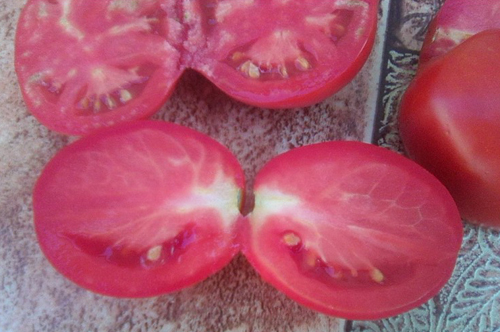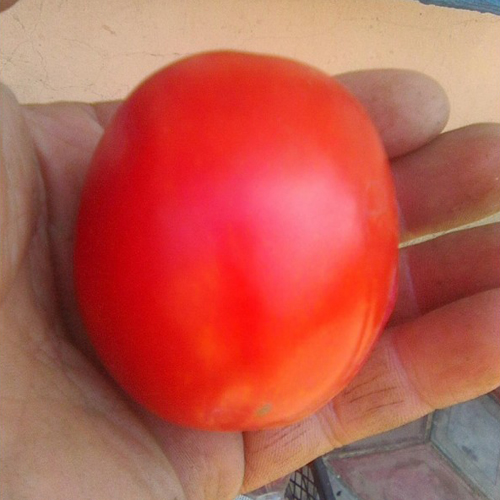Rio grande tomato variety
Lovers of cream tomatoes are probably familiar with the Rio Grande variety, which is appreciated for its high economic characteristics. The variety is not included in the State Register of Breeding Achievements of the Russian Federation, although it is incredibly popular all over the world. The seeds are produced by the Spanish company Greenteam, the American Lark Seeds, and the French Griffaton. Seed material is distributed in Russia by large agricultural firms - SeDeK, Gavrish, Aelita. You can grow a tomato in any region of the Russian Federation, because it grows and bears fruit equally well both in the open field and indoors. But, nevertheless, it enjoys the greatest popularity in the southern regions. Recommended not only for personal subsidiary plots, but also for commercial cultivation. Suitable for mechanical cleaning. Rio Grande is not a hybrid, so you can harvest the seeds yourself.

Description
The plant is determinate, medium-sized, 70 - 100 cm high. But, according to reviews, tomato bushes grow up to 1.5 meters. The stem is strong, the shoot-forming ability is good, the leafiness is moderate. Thanks to this, the bush looks powerful, but compact. The leaves of the variety are of the usual type, petiolate, large, dark green, with a slightly wrinkled surface. 8 - 10 ovaries can form in the fruit cluster.
Fruits are almost one-dimensional, beautiful oval or classic plum-shaped, very dense, smooth. The skin is, one might say, thick, durable, glossy. Unripe tomatoes are green. Ripe ones are filled with an even and bright red color. The pulp has a good density, not watery, fleshy, with thick walls, contains a large amount of dry substances, aromatic, low-seeded, two-chambered. The average fruit weight is 100 - 140 grams. Rio Grande has good taste, sweet and sour taste.

Characteristics
- The variety is mid-season, the crop can be harvested in 110 - 120 days after full germination;
- ripening proceeds at a leisurely pace, so fruiting is stretched to the very frost;
- the yield of ripe tomatoes is unusually high - 98%;
- the yield is very good, subject to the rules of agricultural technology, from 4.5 to almost 8 kg of fruits are removed from one bush. According to reviews, 520 kg were removed from 92 bushes;
- tomato is versatile in terms of withstanding bad weather, including drought. It develops well and continues to set fruit under unfavorable conditions;
- the leaves reliably cover the tomatoes, so they are not afraid of the heat and increased solar activity;
- thanks to the dense skin, the fruits are not susceptible to cracking, even in a rainy period;
- the variety's immunity to the main tomato diseases is great - there is resistance to fusarium, tobacco mosaic virus, verticillosis, gray leaf spot and alternaria stem cancer;

- tomatoes plucked in a state of blanche ripeness are perfectly ripened;
- the commercial qualities of the fruits are excellent, for which Rio Grande is appreciated by sellers and buyers;
- thick skin and dense, elastic flesh make tomatoes unusually suitable for transportation, they are not afraid even of mechanical damage, a tomato that has fallen from a height of human growth will not burst;
- the keeping quality of the fruits is excellent - subject to the storage conditions, the harvest will lie until the end of the year;
- the way of use is universal. The crop is used in its natural form - for salads. They are processed into tomato products - due to the high content of dry matter in the pulp, tomato paste is of excellent quality, however, the juice will not work. The variety is considered one of the best for whole-fruit canning, the oblong shape allows you to conveniently place the fruits in the jar, and the dense skin remains intact. Tomatoes can also be dried, cut into slices or slices, and frozen.
Agrotechnics
Rio Grande is one of the few varieties suitable for sowing directly into the ground. But this method is more suitable for the southern territories. In cooler regions, it is more advisable to grow the culture in a seedling way.Seeds are sown for seedlings in such a way that by the time of the proposed transplantation into the ground, the plants are 60 - 65 days old. The seed germination is good, the seedlings are processed and grown in the usual way. Despite the strong stem, the bush must be tied to a support, the pinching is carried out moderately. The planting pattern is standard - 40 cm between plants in a row, row spacing 50 cm. Recommended density - 4 - 5 plants per 1 square meter. Watering is done in moderation, especially strictly monitoring the moisture of the soil and air in greenhouses. Top dressing is required. At the beginning of tomato growth, nitrogen-containing fertilizers are used, during the period when the ovary appears, phosphorus-potassium fertilizers. In general, the care is simple, it does not differ from the standard one.
Rio Grande is a reliable and versatile variety that experienced gardeners and novices alike enjoy growing. Numerous positive reviews confirm good yield, stress resistance and high immunity of the crop. Housewives also appreciate this species for the opportunity to surprise a family with various blanks, unusually beautiful, healthy and tasty. If you really want to, you can find a drawback - not too juicy pulp and sometimes not quite expressive taste. Of course, year after year does not happen, but if the weather does not fail and agricultural technology is respected, this tomato is really surprising.









Rio Grande was grown for the first time last year, on advice. It was described to me as a field variety, very productive, despite its limited growth, and even does not require any special care, garter or pinching. As fabulous as it sounded, everything turned out to be true: a surprisingly productive and hardy variety. I still had to tie it up because of the severity of the brushes with fruits, but I did not tie each bush separately, but whole rows. On April 25, some of the tomatoes were planted in small seedlings in the ground (at the stage of 1 - 2 true leaves), 2 roots per hole, and some were sown with dry seeds (all according to the scheme 30 × 70 cm). They sprouted from the seeds only on May 15 and, accordingly, later bore fruit. On June 26, there were the first ovaries, and on August 16, tomatoes were already picked in buckets.
They have a good taste, the tomato itself is fleshy, but the skin is harsh (but they lie well and do not wrinkle during transportation). From leaving - only a garter and rare watering. Neither the abnormally hot summer, nor the thickening of the plantings, nor the lack of "dancing with a tambourine" around them did not prevent the Rio Grande from loading my family with work on the conservation of tomato juice, since the harvest was more than we could eat and distribute.